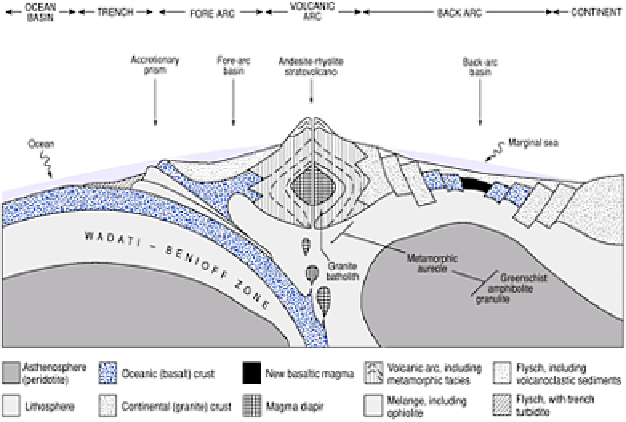Environmental Engineering Reference
In-Depth Information
Figure 10.8
The tectonic morphology and principal rocks of
destructive plate margins.
pelagic
debris
rained out
from the overlying ocean and
flysch
, derived from the adjacent
continent and swept into the trench by
turbidity currents
. Their low density resists
subduction and these sediments eventually compose the bulk of the accretionary prism by
offscrape
, as the upper side of the descending slab scrapes against the non-subducting
plate. Successive offscrapes occur on the underside of the prism, which occasionally
emerges above sea level. Accretion can be augmented by slivers of layered oceanic crust
sheared off during subduction and known as
ophiolite
in the
mélange
, or chaotic mix of
rock material, forming the prism (Figure 10.8). Ophiolite found high in the Alps and
Himalayas is important evidence of the power of plate tectonics. So too are the north-
east-south-west parallel bands of rocks, ageing northwards and now forming the Scottish
southern uplands, which represent the accretionary prism of the closing Lower Palaeozoic
Iapetus Ocean.
Trench-arc distances are determined by the angle and rate of subduction, since the
volcanic arc overlies the zone of maximum melt. At angles below 25° slab may be
resorbed without vulcanism; 30-60° provides a fore-arc width of approximately 200 km,
and steeper angles can halve this distance. The episodic,
explosive
volcanic eruptions of
volcanic arcs, exhaling gases and ejecting ash and larger debris or
tephra
, contrast with
continuous,
effusive
outflows of basaltic lava at mid-ocean ridges. As the arc matures the
depth of its magma source increases, causing geochemical compositional changes as
different mineral cocktails fractionate from the wet, subducted oceanic crust and adjacent
melted asthenosphere. Early melts produce silicate-poor, less viscous basalt-andesite
volcanoes, switching to silicate-rich, more viscous andesite-rhyolite later. Intrusive, non-
eruptive granitic magmas solidify below the surface and become exposed only by
subsequent erosion. These processes are detailed in Chapter 12.

